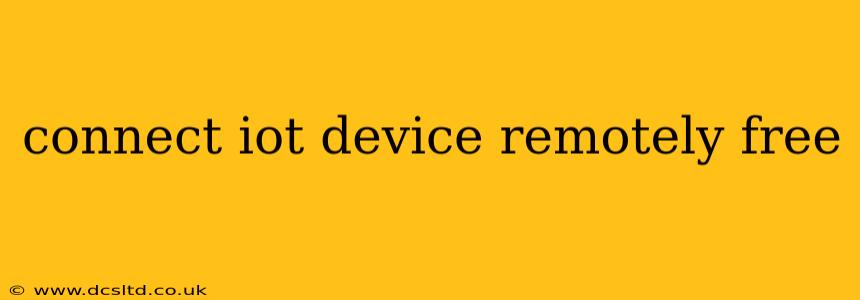Connecting your Internet of Things (IoT) device remotely without incurring costs can seem appealing, but it's crucial to understand the limitations and explore the various methods available. While completely free remote access might be challenging for complex setups, several options offer cost-effective solutions or free tiers with restrictions. This guide explores these options, highlighting their advantages and disadvantages.
What are the Different Ways to Connect an IoT Device Remotely?
Several methods allow remote connection to your IoT devices, each with its own cost implications and capabilities.
-
Using a Public Cloud Platform: Services like AWS IoT Core, Google Cloud IoT Core, and Azure IoT Hub offer managed services for connecting and managing your IoT devices. While they often have free tiers, these typically have limitations on the number of devices, messages, and data storage. Once you exceed these limits, costs will apply.
-
Self-Hosted Solutions: Setting up your own server infrastructure can offer greater control, but it requires technical expertise and ongoing maintenance. The upfront cost of hardware and the ongoing cost of electricity and potentially bandwidth can outweigh the benefits for simpler use cases. Free options are limited, typically requiring significant self-hosting knowledge.
-
Using a VPN: A Virtual Private Network (VPN) can create a secure connection to your home network, enabling access to devices on that network. While some free VPNs exist, they often come with limitations like slower speeds, data caps, and security concerns.
-
Using Port Forwarding: This technique allows external access to specific ports on your home router, enabling remote access to devices that use those ports. This requires a static IP address or a dynamic DNS service, which might incur monthly fees.
What are the Limitations of Free Remote Access?
Free remote access options often come with several limitations:
-
Limited Bandwidth: Free services usually restrict the amount of data you can transmit. This can be a problem for devices that generate significant amounts of data, such as cameras or sensors.
-
Limited Number of Devices: Many free services restrict the number of IoT devices you can connect.
-
Security Concerns: Free services may not offer the same level of security as paid options. This can expose your devices to vulnerabilities and attacks.
-
Performance Issues: Free services often have lower performance levels than paid services, leading to delays and instability.
-
Feature Restrictions: Free tiers usually lack advanced features found in paid plans, such as device management tools, data analytics, and robust security protocols.
How Can I Secure My Remotely Connected IoT Device?
Regardless of whether you're using a free or paid service, securing your IoT device is crucial. Consider these steps:
-
Strong Passwords: Use strong, unique passwords for your devices and network.
-
Regular Software Updates: Keep your device's firmware and software up-to-date to patch security vulnerabilities.
-
Firewall Protection: Configure a firewall to restrict access to your device only from trusted sources.
-
Two-Factor Authentication (2FA): If available, enable 2FA for added security.
-
Encryption: Utilize end-to-end encryption to protect your data in transit.
Can I Connect My IoT Device Remotely Using Only My Smartphone?
You can remotely connect some IoT devices using your smartphone as a gateway. Many devices have companion apps that facilitate this. However, this approach depends on the capabilities of your specific device and its accompanying app. The connection may be limited to the smartphone's range (when using mobile data) and may not be suitable for devices requiring constant monitoring or remote control beyond a limited area.
Which Free Cloud Platform is Best for Connecting IoT Devices?
There is no single "best" free cloud platform for IoT devices. The ideal platform depends on your specific needs and the type of device you're connecting. All major cloud platforms (AWS, Google Cloud, Azure) offer free tiers, but each has its limitations and strengths. It's advisable to carefully review the documentation for each platform to determine if it meets your requirements and limitations.
This guide provides a comprehensive overview of how to connect your IoT device remotely for free, examining available options while acknowledging the associated challenges and limitations. Remember to prioritize security to protect your device and data.
